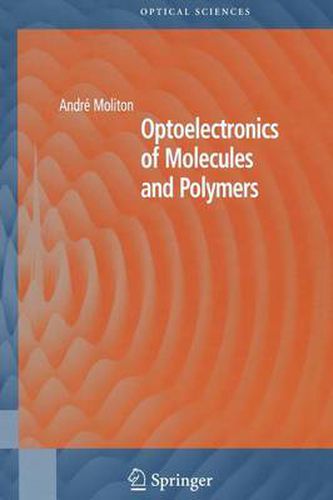Readings Newsletter
Become a Readings Member to make your shopping experience even easier.
Sign in or sign up for free!
You’re not far away from qualifying for FREE standard shipping within Australia
You’ve qualified for FREE standard shipping within Australia
The cart is loading…






This title is printed to order. This book may have been self-published. If so, we cannot guarantee the quality of the content. In the main most books will have gone through the editing process however some may not. We therefore suggest that you be aware of this before ordering this book. If in doubt check either the author or publisher’s details as we are unable to accept any returns unless they are faulty. Please contact us if you have any questions.
Optoelectronic devices are currently being developed at an extraordinary rate. Organic light-emitting diodes, photovoltaic devices and electro-optical modulators are pivotal to the future of displays, photosensors and solar cells, and communication technologies. This book details the theories underlying the mechanisms involved in the relevant organic materials and covers, at a basic level, how the organic components are made.
The first part of the book introduces the fundamental theories used to describe ordered solids and goes onto detail on concepts applicable to localised energy levels. Then the methods used to determine energy levels particular to perfectly ordered molecular and macromolecular systems are discussed along with a detailed consideration of the effects of quasi-particles. The function of excitons and their transfer between two molecules is studied and, in addition, the problems associated with interfaces and charge injection into resistive media are presented.
More technological aspects are covered in the second part, which details the actual methods used to fabricate devices based on organic materials, such as dry etching. The principal characterisation techniques are also highlighted. Specific attention is paid to visual displays using organic light-emitting diodes; the conversion of photons into electrical energy (the photovoltaic effect); and for communications and information technologies, the electro-optical modulation of signals.
$9.00 standard shipping within Australia
FREE standard shipping within Australia for orders over $100.00
Express & International shipping calculated at checkout
This title is printed to order. This book may have been self-published. If so, we cannot guarantee the quality of the content. In the main most books will have gone through the editing process however some may not. We therefore suggest that you be aware of this before ordering this book. If in doubt check either the author or publisher’s details as we are unable to accept any returns unless they are faulty. Please contact us if you have any questions.
Optoelectronic devices are currently being developed at an extraordinary rate. Organic light-emitting diodes, photovoltaic devices and electro-optical modulators are pivotal to the future of displays, photosensors and solar cells, and communication technologies. This book details the theories underlying the mechanisms involved in the relevant organic materials and covers, at a basic level, how the organic components are made.
The first part of the book introduces the fundamental theories used to describe ordered solids and goes onto detail on concepts applicable to localised energy levels. Then the methods used to determine energy levels particular to perfectly ordered molecular and macromolecular systems are discussed along with a detailed consideration of the effects of quasi-particles. The function of excitons and their transfer between two molecules is studied and, in addition, the problems associated with interfaces and charge injection into resistive media are presented.
More technological aspects are covered in the second part, which details the actual methods used to fabricate devices based on organic materials, such as dry etching. The principal characterisation techniques are also highlighted. Specific attention is paid to visual displays using organic light-emitting diodes; the conversion of photons into electrical energy (the photovoltaic effect); and for communications and information technologies, the electro-optical modulation of signals.